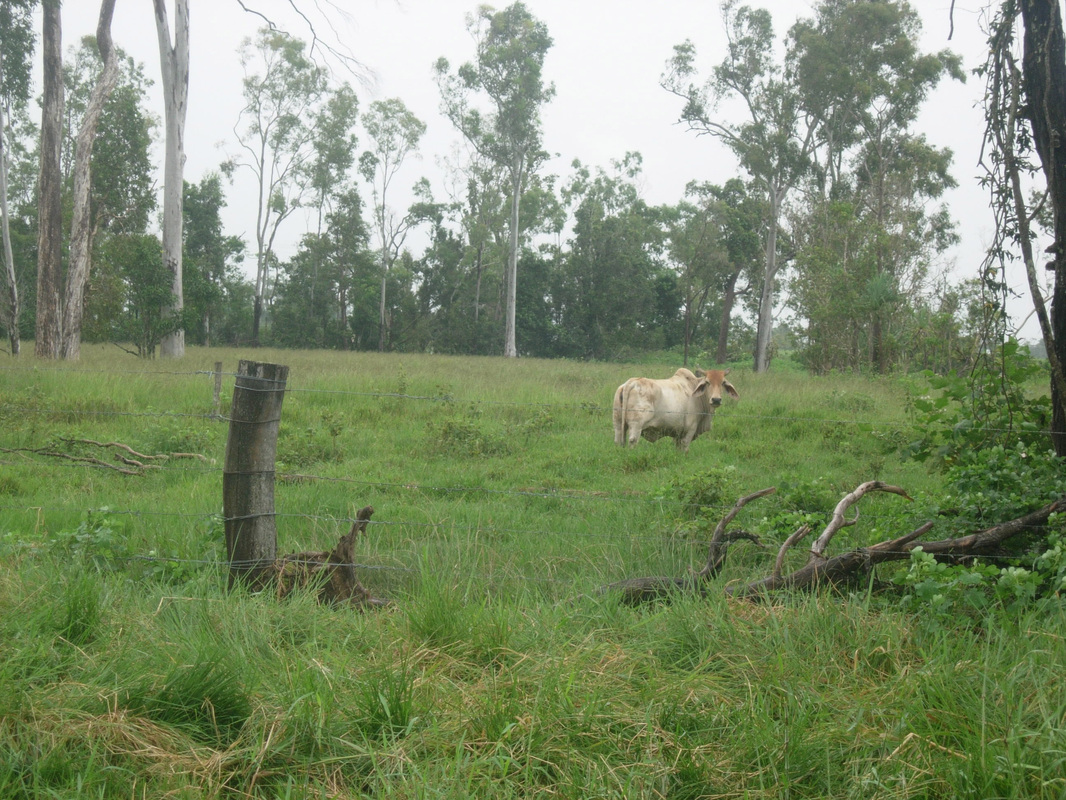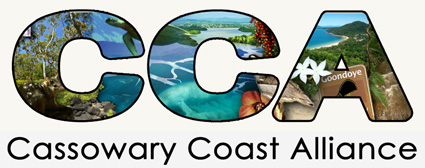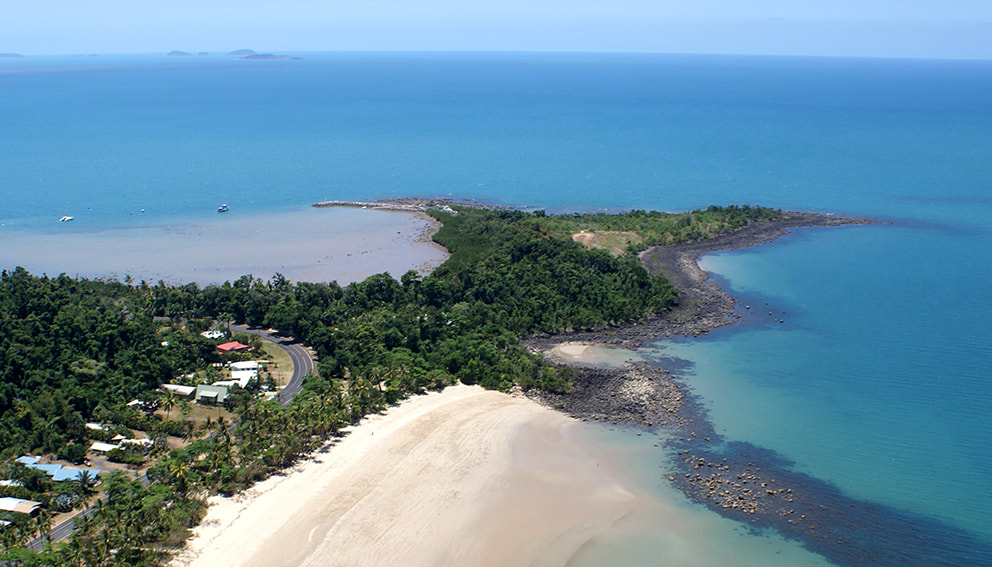| By ANNE WILKINSON It has been a week of what I can only call coincidences and discoveries. Take the coincidence first, though I guess in fact it is more a confirmation of what we – and wildwatchers everywhere – have always known. It happened at a Christmas party. We were admiring the view across paddocks to the distant mountains from the large, rambling and very beautiful garden where the party was being held. Dusk was falling and the last birds were hastening to their roosts while bats were beginning to emerge and swoop after insects. |
Among the birds we saw a pair of Torres Straits pigeons flying inland to the forest rather than, as we would have expected, out to the offshore islands to roost after a day of feeding inland. We saw wallabies and I asked our host about other animals since it was a very rural area. The house was on a slight crest rising above paddocks.
“We don’t see many at all because we are in effect on an island in the middle of cane, cattle and bananas,” our host replied, and I realised, looking around, that this was true. There were no lines of trees along paddocks to support animals such as gliders, nor was there woodland except the plantings in the garden itself. The surroundings were completely given over to agriculture, so while the large garden might have been a refuge there was no way for animals to reach it.
Which made me think of what we in WPSQ call paddock trees, those single trees or copses which not only provide shade for stock but allow wildlife to move with safety across distances between feeding areas and find mates outside their own increasingly restricted habitat areas.
These trees certainly add beauty to the landscape, but have their practical uses such as encouraging birds and animals which eat insect pests, help to keep stock cool and healthy, store carbon and, if planted in sufficient numbers, reduce or stop dieback.
The good news is WPSQ is so pleased with its last paddock tree give-away that another is proposed. Watch this space for news.
Another happening, a near tragedy during the week, proved to be a real learning curve.
There was a bang on the window while we were having breakfast on Monday morning.
A fluff of flying feathers indicated a bird had smashed into it. There it was on the ground,
a little brown ball of feathers, one wing raised and trembling. It had probably been chased, perhaps by a kookaburra or a black butcher bird.
Lawrie gently picked it up. It was still alive but quite knocked out, so he moved it into the shade to recover. Very often birds recover quite quickly and in a few minutes, after they have collected their scattered senses, fly away.
This one didn’t.
It recovered consciousness but its attempt to fly was just a pitiful scramble as if its wing was hurt. Fearing it would be attacked again, Lawrie picked it up and put it in a box on a towel. Quiet, darkness and four walls give a sense of security to an injured animal. Lawrie was going into town so he took it to the vet, who did not think the wing was broken. When he called to pick it up some hours later the little bird was still alive, but needed to remain under observation as it was still decidedly wobbly.
But by morning we heard it was a different story.
The bird – we believe it was a brown honeyeater – had completely recovered and had been allowed to fly where, it was reported, it had taken to the air strongly.
Rest and quiet had given it back its life, and we were delighted.
It is always hurtful to see a creature suffer, but as a friend put it, perhaps we humans are sometimes too hasty in opting for euthanasia when things seem bad. We would have given nothing for its chances the day before, but all it had needed was time.
Probably it was concussed, which would have accounted for its temporary wobbly state, but giving it the benefit of the doubt had allowed time to work its miracle.
For the little bird, all had ended well.
Drongos. Did the name come before its human connotation, or was it the other way around?
We have had amused reports of drongos flying to heights then free falling until they nearly hit the treetops, just like avian skydivers.
These black, streamlined birds with the big voices are prodigious flyers. We have often watched them swoop on insects above the pool, almost touching the water but never quite going under, in a wonderful display of athleticism.
The theory is that the free falling was part of a mating display. Or it could have been play.
Whichever it was, it was heart stopping.
“We don’t see many at all because we are in effect on an island in the middle of cane, cattle and bananas,” our host replied, and I realised, looking around, that this was true. There were no lines of trees along paddocks to support animals such as gliders, nor was there woodland except the plantings in the garden itself. The surroundings were completely given over to agriculture, so while the large garden might have been a refuge there was no way for animals to reach it.
Which made me think of what we in WPSQ call paddock trees, those single trees or copses which not only provide shade for stock but allow wildlife to move with safety across distances between feeding areas and find mates outside their own increasingly restricted habitat areas.
These trees certainly add beauty to the landscape, but have their practical uses such as encouraging birds and animals which eat insect pests, help to keep stock cool and healthy, store carbon and, if planted in sufficient numbers, reduce or stop dieback.
The good news is WPSQ is so pleased with its last paddock tree give-away that another is proposed. Watch this space for news.
Another happening, a near tragedy during the week, proved to be a real learning curve.
There was a bang on the window while we were having breakfast on Monday morning.
A fluff of flying feathers indicated a bird had smashed into it. There it was on the ground,
a little brown ball of feathers, one wing raised and trembling. It had probably been chased, perhaps by a kookaburra or a black butcher bird.
Lawrie gently picked it up. It was still alive but quite knocked out, so he moved it into the shade to recover. Very often birds recover quite quickly and in a few minutes, after they have collected their scattered senses, fly away.
This one didn’t.
It recovered consciousness but its attempt to fly was just a pitiful scramble as if its wing was hurt. Fearing it would be attacked again, Lawrie picked it up and put it in a box on a towel. Quiet, darkness and four walls give a sense of security to an injured animal. Lawrie was going into town so he took it to the vet, who did not think the wing was broken. When he called to pick it up some hours later the little bird was still alive, but needed to remain under observation as it was still decidedly wobbly.
But by morning we heard it was a different story.
The bird – we believe it was a brown honeyeater – had completely recovered and had been allowed to fly where, it was reported, it had taken to the air strongly.
Rest and quiet had given it back its life, and we were delighted.
It is always hurtful to see a creature suffer, but as a friend put it, perhaps we humans are sometimes too hasty in opting for euthanasia when things seem bad. We would have given nothing for its chances the day before, but all it had needed was time.
Probably it was concussed, which would have accounted for its temporary wobbly state, but giving it the benefit of the doubt had allowed time to work its miracle.
For the little bird, all had ended well.
Drongos. Did the name come before its human connotation, or was it the other way around?
We have had amused reports of drongos flying to heights then free falling until they nearly hit the treetops, just like avian skydivers.
These black, streamlined birds with the big voices are prodigious flyers. We have often watched them swoop on insects above the pool, almost touching the water but never quite going under, in a wonderful display of athleticism.
The theory is that the free falling was part of a mating display. Or it could have been play.
Whichever it was, it was heart stopping.









 RSS Feed
RSS Feed